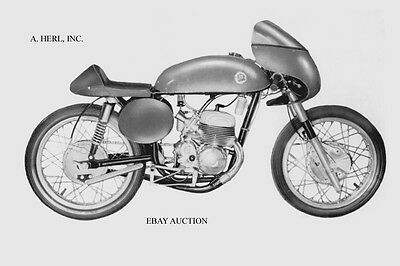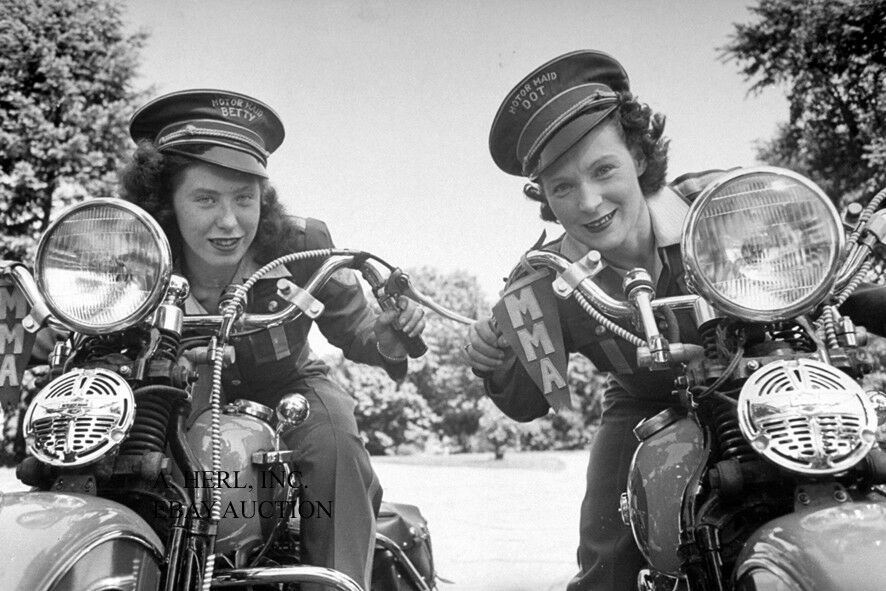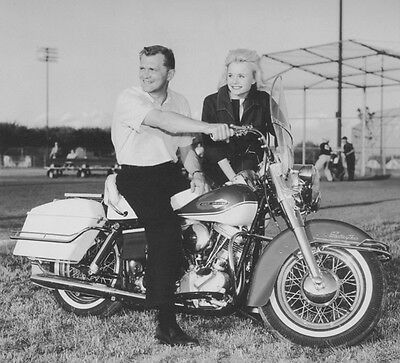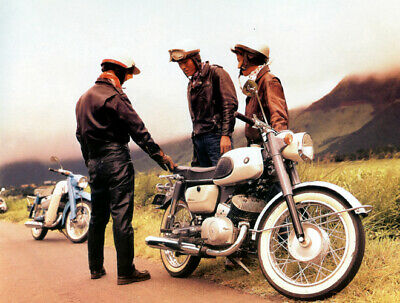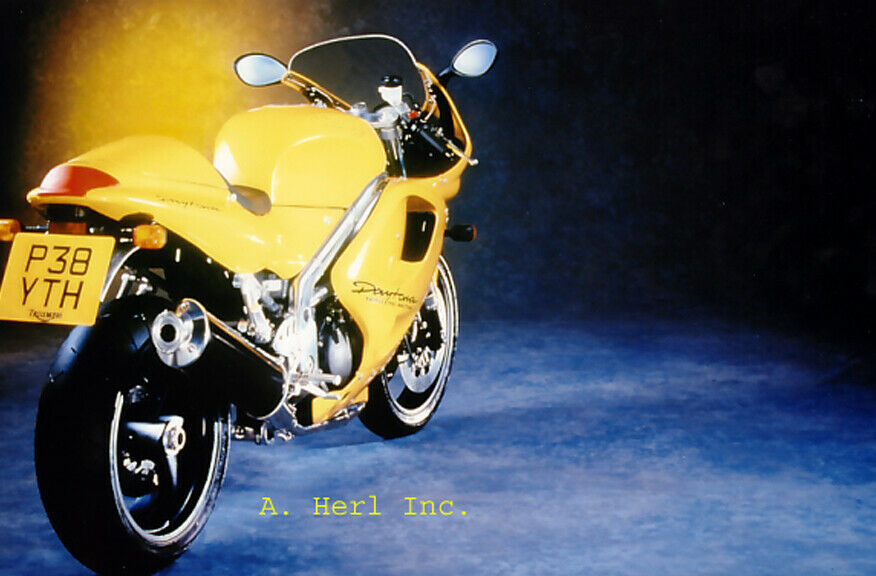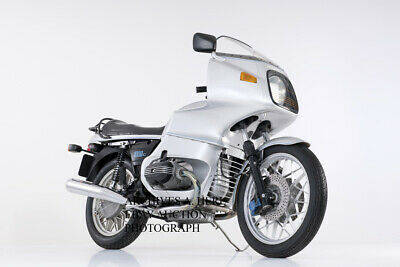-40%
Montesa Sportsman production racer - 1961 - motorcycle racing photo photograph
$ 5.14
- Description
- Size Guide
Description
A superb and rare photo of the successfulMontesa Sportsman production racer
of
1961
, the year this exiting new racer was introduced.
This photograph was made for the brochure of the new model. The bike stands on a white sheet against a white background, creating the perfect conditions for retouching the background way for a mint and crisp image of the bike without a cluttered and disturbing background. It is a great photograph, as it shows the new Brio 110 fully original as it left the factory production lines moments earlier!
The
Montesa 350 Sportsman
was introduced in 1961. It featured a very nicely build 347.95cc single cylinder two stroke engine, with a bore and stroke of
51.5 x
64 mm
, delivering a power output of 47.5 bhp at 8,500 rpm. The engine had a compression ratio of 10 : 1. The gearbox had five speeds.
The negative dates from 1961., it was made from a large retouched model photograph.
Like many other automotive factories, Montesa used to retouch original photos to make the bike look as smart as possible, deleting clutter and loose cables to give a nice pristine image of the motorcycle. In the case of this photo, the background was “whited out” as well. The result is a photograph that looks as historic as it does gorgeous!
Montesa
was formed in 1944 by Pedro Permanyer and Francisco Xavier "Paco" Bulto. Their first Montesa prototype was based upon the French Motobécane models of that time. Permanyer began to produce his own gas engines, which allowed for a new area in motorcycles to be explored and expanded into. Permanyer and Bultó teamed up in
Barcelona
and created a light-weight motorcycle. This led to the creation of a bike powered by a 95cc two-stroke engine with no rear suspension. Despite some setbacks, they sold 22 of these units in the first year of production. The next year, the partnership focused on production improvements and meeting the growing demand for their bike. As a successor to the previous model, Bultó designed a new 125cc roadster, which was tested in many the trail-type rallies and semi-enduros that were popular in
Spain
at the time. This model went on to enter the 1951 International Six Days Enduro. The bike was entered in by the factory, being ridden by Bultó and G. Cavestany. In the early 1950s, Montesa entered many races in the 125cc class of road racing. These bikes featured six-speed, bolt on gearboxes, in semi-unit construction, with all gears running on needle-roller bearings. By 1956, these Montesa 125s were very competitive and took second, third and fourth places in the Ultra-Lightweight race at the Isle of Man TT. The most successful
Montesa street
bike of the '50s was the Brio 80, of which more than 12,000 were produced. The success of the Brio and the other models, led to the opening of a new and larger factory in Espluges de Llobregat. The Brio 80 and Brio 90 models contained many new advances, such as moving the carburetor behind the cylinder, and a handbrake. However, a slump in the Spanish economy had forced Permanyer to cut back on the company's racing activities. Permanyer wanted to pull out of road racing, but Bultó insisted that they stay in. In May 1958, chief designer Bultó left, taking with him several of Montesa's vital personnel. Permanyer had not only lost the brilliant designer Bultó, but also his 30% share of the company. Fortunately for both,
Spain
's economy began to improve. Permanyer promoted the all-around champion motorcyclist Pedro Pi from head test rider to chief development engineer. Leopold Mila was made Technical Director and Permanyer's son Javier, was to be Sports Assistant. Work began right away on designing a brand new all-unit-construction 175cc engine that by 1960, would power the latest Impala sports roadster model. This engine would form the basis of the company's future trials and motocross machines. To promote sales of this model, three Impala's were taken to
Africa
where they covered over
12,000 miles
of terrain, most of it being off-road. Back in
Spain
, Pi was busy winning the Spanish motocross and road race championships and working on a new 250cc version. Following its introduction in 1965, the 250 engine would be the cornerstone of the company's future success. Mounted on the new 250 Scorpion scrambler, Pi won the Spanish championship again in 1966 and the similarly engined Sport roadster won the
Barcelona
24-hour endurance road race. In 1967 the first Montesa trials models appeared and in 1968 retitled the Cota, Pi won the Spanish Trials Championship. After adding this title to go along with the road race and six motocross titles, he retired from competition to devote his full energy to bike development. In the decade following, Montesa had unprecedented growth around the World and one has to remember that unlike Bulto's bike, the Bultaco, Montesa only sent a small percentage of its production to the States, concentrating mostly on the European market. Trials models were offered in many different sizes 25, 49, 125, 175, 250, 348 and 349, as were motocrossers 125, 175, 250, 360 and 414. This also included a line of street and Enduro models also. In 1973, the VR (Vehkonen Replica) was released and set the standard for 1974, as did the 348 Cota did in 1976. Ulf Karlsson won the World Trials Championship on a Cota in 1980. By 1981, another round of economic unrest in
Spain
began to hinder motorcycle manufacturers. Strikes and a shrinking market left Montesa as the only major motorcycle concern in the country; however they were in need for a major influx of capital in order to continue to survive. A loan from the government and shares sold to Honda (to establish a European manufacturing base for their commuter bikes) helped production continue. Montesa was still active in World Trials competition throughout the 1980s and into the 1990s. Even though reduced to only offering one model, the Cota, such riders like former World Champion Eddy Lejeune and Andrew Codina rode the bike to good results in the mid-'80s. In 1992-93, the liquid-cooled Cota 311 was produced; this was to be the last "real" Montesa. In
1994, a
new model, the 314R, was introduced. This model featured an HRC Honda powerplant with many other components from Honda. Montesa-mounted Marc Colomer won the World title in 1996 and the 315R followed in early '97. The 315R had a run of 7 years, taking Dougie Lampkin to many world championships, and was replaced by the technically advanced four-stroke Cota 4RT in 2005.
We have more photos listed on Ebay, also motorcycle (racing) photos! Check them out and use the shipping discount!
This is your rare chance to own this
non period
photo that reflects a very interesting and historic piece of motorcycle and Montesa history. Therefore it is printed in a nice large format of ca. 8" x 12" (ca. 20 x
30 cm
).
Shipping costs will only be $ 7.00 regardless of how many photos you buy. For 5 or more photos, shipping is free!
(Note: A. Herl, Inc. does not appear on photo, for ebay purposes only)
No copyright expressed or implied. Sold as collectable item only. We are clearing out our archives that we have gathered from various sources.
All items always sent well protected in PVC clear files
and board backed envelopes.
We have photographs that came from professional collections and/or were bought from the original photographer or press studio! They are all of professional and excellent quality.
After many decades of professionally collecting photographs and posters we are clearing out our archives. They make the perfect gift and are perfectly suited for framing. They will look gorgeous unframed and will be a true asset nicely framed with a border. They are a gorgeous and great asset in every home, workshop, workplace, restaurant, bar or club!
First come - first served. And you can always contact us for your requests. Please ask any questions before the auction ends.
